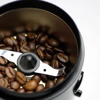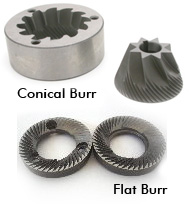|
Ground coffee starts to lose flavor and coffee oils after 2 days. So, unless you can finish the whole pack in 2 days, if not, most of the time you would be drinking stale coffee. Coffee beans on the other hand can maintain freshness for up to a few months with the right storage.
Coffee grinders can also be used for spices. Same reason to grind. There are two basic types of grinder, Blade and Burr.
Wheel or flat Burr - The less expensive of the two burr grinders. The wheel spins very fast, and these grinders can be noisy. The higher speed rotation make these grinders more messy as well. Conical Burr - The best grinders you can get (one web site said there are flat burr grinders that are just as good.) are conical burr grinders. The burr spins slower than the wheel model, which makes them quieter and less messy. You can use a conical burr grinder for oily or flavoured coffees and it's not likely to clog, like the other kinds of grinders. These are the best type, but you will pay the price for them. Except for coffee makers with built-in units, all grinders produce messy grind residue. While basic blade grinders require minimum maintenance, it's the additional features that tend to add to the clean-up, which may be a consideration when choosing features. Burr grinders tend to require a lot more care and cleaning with a small brush, to keep them in good operating condition. If you want to minimize clean-up and you're not too fussy as to grind consistency, go for a basic blade grinder. On the other hand, if you're particular about your coffee and want the finest grind possible, be prepared for the extra work.
Some grinders (e.g. the The DeLonghi DCG39 below), store the beans and you can select the amount you want to grind for each use.
Grinding coarseness: | |||||||||||||||||
|
| ||||||||||||||||
|
Shorter brewing time would require a finer grind, i.e. when making an espresso. So, conversely, the longer brewing time would require a coarser grind, i.e. when using a French press. Too fine a grind for a particular brewing process will result in over extraction and bitter, pungent tasting coffee. Too coarse a grind will result in weak, watery coffee.
Some recommended models: (Scores are from TestFreaks and Amazon)
CoffeeGeek says if you are spending $150-$250 on an expresso machine, then you should spend the same amount on the grinder.
I've only listed electric models; There are also hand crank models. There are also combination grinder/brewers. e.g. the Cuisinart-DGB-700 ($170), but most aficionados feel a separate components are better.
Delonghi KG79 burr grinder $60 May not grind fine enough for expresso. - Score 4.0-4.9
The Breville Smart Grinder, $195 will also impress your friends.
Links:
| |||||||||||||||||

 Blade grinders don't have a coarseness setting. You just let it run longer for a finer grind. However one web site said you should not use blade grinders for expresso or Turkish coffee.
Blade grinders don't have a coarseness setting. You just let it run longer for a finer grind. However one web site said you should not use blade grinders for expresso or Turkish coffee.

 The DeLonghi DCG39, bade grinder, $30 is recommended at
The DeLonghi DCG39, bade grinder, $30 is recommended at 



